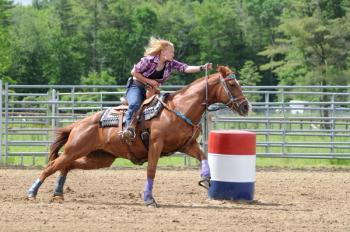
Colic: The deciding factors – from referral to surgery (Proceedings)
Thorough and timely assessment play a significant role in successful treatment of the critical colic.
All colics are not created equal
• Thorough and timely assessment play a significant role in successful treatment of the critical colic
• Making a decision for referral early can significantly influence the outcome
• Survival is directly correlated to early diagnosis and treatment
Field diagnostics
• Components of the colic examination
o Physical exam
o Rectal
o Abdominocentesis (belly tap)
o Ultrasound
o Nasogastric intubation
• Physical exam
o Pain status
o Heart rate
• Normal = 36-44
o Temperature
• Normal = 99.5-101
o Respiratory rate
• Normal = 12-16
o Mucous membranes
o Normal = pink, moist, CRT <2 sec
o Gastro-intestinal sounds
• Present? Not present? Increased? Decreased? Gas?
o Evidence of pain
o Abdominal distention
• Examination per rectum
o Slow initial entry into rectum
o Left dorsal quadrant to find the spleen
o Clockwise examination
o Detect all fixed structures
o Buscopan (0.3 mg/kg) can facilitate rectal
• Rectal examination
o What you are feeling for:
• Abnormal distention.
• Abnormal position.
• Abnormal mass.
• Abnormal peritoneal surface.
• Abdominal ultrasound
o Can be performed in the field
o Preferable a 5-10 MHz microconvex probe or 2.5-5 MHz sector scanner
o Can sometimes use linear probe percutaneously if it is at lease a 5 MHz, but is more difficult
o Can use reproduction probe transrectally sometimes to evaluate SI distention and motility palpated rectally
o Abdominal ultrasound
• The sweet spots:
• Inguinal region
• Just abaxial to midline
• Identify position of spleen and locate left kidney (for nephrosplenic rule-out)
• Abdominocentesis
o Can be performed in the field
• Teat cannula or 18 gauge – 1.5" needle
• Aseptic prep
• At most dependent portion of the abdomen
• Just abaxial to midline
• Gross analysis of fluid – serosanguinous or not?
o Can carry refractometer – evaluate protein (normal = < 1.0 g/dl)
o Nasogastric intubation
o Reflux and gastric lavage
o Fluid obtained should be less than 2 L
o Perform lavage if significant feed material obtained – gastric impaction??
o If > 2 L net back – do not give oil, H2O or electrolytes
Making a diagnosis
• Sequence of diagnosis
o Categorize as ileus, obstruction, strangulation, enteritis or peritonitis
o Identify segment of intestine involved
o Categorize the severity
o Look for specific signs related to a specific disease: Make a diagnosis
o Risk factors for a specific disease
Decision for referral
• 2-4 % of horses with colic will need surgery
• The decision for surgery is best made early
Questions:
o Is pain responsive to analgesia?
o Do exam findings indicate surgery?
o Do exam findings indicate extensive medical treatment (enteritis)?
o Is horse insured?
o Is surgery an option?
• Surgeon's basis for referral (Peloso JG, Proc AAEP 1996; 42:250-253)
o 100%- Unrelenting pain
o 96%- History of increasing pain
o 95%- Marked abdominal distention
o 92%- Chronic pain for 5 days
o 87%- Analgesics don't relieve pain
o 85%- Serosanguinous peritoneal fluid
o 79%- Increased protein in peritoneal fluid
o 89%- Purple/cyanotic MM
o 95%- HR, CRT, and PCV increased on second examination
o 89%-Gaseous distention of SI
o 92%-Feed impaction not resolved in 3 days
• Surgery is a diagnostic tool
• Refer for a second opinion rather than surgery
• Refer early to increase survival
• Pre-plan surgical referral for colic
Protocol for referral
• Stomach tube in place if refluxing
• Administer flunixin meglumine if > than 6 hours from 1st dose
• Administer antibiotics +/ -
• Administer intravenous fluids
• Case dependent
• Provide analgesic/sedative for transport
How is the decision for surgery made once referred?
• History
• Referring veterinarian's findings
• Repeat diagnostics - what has changed?
• Rectal exam
o In a multi-center study an abnormal rectal exam was most important factor in determining need for surgery (Reeves et al AJVR 52(11):1903-07, 1991)
o Not a sensitive diagnostic
o A normal rectal exam does not rule out a surgical problem, but an abnormal rectal is not definitive
• Reflux
o Obstruction or Enteritis?
o Pain is responsive to gastric decompression in enteritis
o Enteritis usually has large volumes of foul smelling fluid
• Ultrasound
o Marked SI distention, no motility, and thickened wall are indications for surgery
o Can confirm nephrosplenic, inguinal hernia, diaphragmatic hernia, intussusceptions
• Peritoneal fluid
o Serosanguinous
o Normal values
• Protein= 0.7 - 1.5 g/dl ???
• WBC= 200-3,000/ul, ratio of neutrophils to mononuclear cells = 2:1
• RBC= rare
o Simple obstruction
• Normal fluid
• Increased protein
• Normal RBC and WBC
• Degenerate WBC increase with longer duration of obstruction
o Strangulation obstruction
• Increased protein >2.0 g/dl
• Increased RBC early > 20000/ul
• Increased WBC as lesions progresses; 5000 to 50,000 WBC/ul
• WBC degeneration and intracellular bacteria with intestinal necrosis
o Thromboembolic colic and peritonitis
• Protein >2.0 - 6.5 g/dl
• RBC normal to serosanguineous
• WBC normal to >400,000 /ul
• Free and intracellular bacteria
o Proximal enteritis
• Protein; 2.0 to 6.5 g/dl
• RBC; variable
• WBC; normal (increased later in disease)
o Indications for surgery
• Serosanguineous; RBC > 20,000/ul
• Acute increase in WBC >5,000/ul with > 90% neutrophils (+)
• Increased protein (+)
• Intracellular bacteria (+)
• Blood work
o Changes in WBC
• ↓ WBC of <4000 cell/µl – consumptive process
• Endotoxemia from strangulation, enteritis/colitis
• ↑ WBC >18,000 cell/µl likely non-surgical, infectious
o PCV
• Hydration status
• Circulatory status – markedly increased with shock
o Total protein
• Lost through diseased gut
• ↓ indicates GI loss and disease
• Decreased or normal TP in face of markedly elevated PCV is sign of significant GI compromise
o Blood gas / chemistry
• Metabolic derangements (acidosis/alkalosis)
• Electrolyte levels
• Renal values (BUN/creatinine) for hydration
• Lactate (normal = < 2 mmol/L)
• Marker or peripheral perfusion and elevations secondary to hypoxia
• Important indicator of systemic illness and dehydration
• Can be prognostic indicator: horses with lactate > 11.2 mmol/L have poor prognosis
o Response to treatment
o Uncontrollable pain
• # 1 is level of pain and response to analgesia and/or fluid therapy
• Secondary considerations:
o Rectal examination
o Abdominocentesis
o Physical exam findings
• Pain non-responsive to analgesia is biggest indicator for surgery
• Surgery itself is a diagnostic tool....
• Always better to err on the side of surgery, and operate on a few that don't have a surgical problem, than wait too long on a horse that does
Outcome and recovery
• Small intestine
o Strangulating lesion
• Lipoma
• Mesenteric rent
• Epiploic foramen entrapment
• Hernia
o Enteritis
• Not typically a surgical lesion
• Does cause severe pain from distention
o Factors influencing survival
• Resection or not
• Influenced by early referral
• Type of resection performed
• Jejunojejunostomy – 81-91% short term survival
• Jejunocecostomy – 71-76% short term survival
• Long term no difference between two
• Necessity for second surgery during hospitalization
• Development of ileus
• Short term survival:
o 49% (1974-1980, 1968-1986)
o 85-92% (1994-1999)
• Long term survival >7 months
o 52% (1987-1991)
o 75% (1994-1999)
• Percentage of survival has increased over time with better surgical techniques and post-operative care
• Large intestine
o Displacement
o Impaction
o Segmental infarction
o Torsion
o Factors influencing survival
• Simple large colon displacements - > 80%
• Large colon volvulus:
• Survival 12-60%
• 3% if treated less than 4 hours from onset of signs
• Time from onset to correction plays significant role in survival – greater than 4 hours significantly reduces survival
• Recovery
o 4 weeks of stall rest with hand walking followed by 4 weeks of small paddock turnout
o Complications such as laminitis or incisional infection will prolong activity restriction
o Rarely send home when intensive treatment is needed
• Myth: My horse will not be useful following colic surgery
• Fact: Following appropriate recovery period and no significant complications horses should return to previous activity and level of performance
o In 100 cases 91% returned to expected level of performance (Launois T et al Equine Colic Research Symp 2005: 53-55 )
Newsletter
From exam room tips to practice management insights, get trusted veterinary news delivered straight to your inbox—subscribe to dvm360.





